Charlie has been in touch with some simple track plan layouts – and one very ambitious one.
And he got me thinking.
Do most of us wing it, or religiously work from a track plan?
“Al:
I’ve been playing at HO layouts for years, but finally decided to get serious about it.
A design that has been in the back of my mind since 1965 is finally on paper, with plans to start building as soon as I can bribe my wife into letting me have the garage.
I have tried my hand at scenery, but I would rather run trains.
Here are a few layouts I offer free to anyone interested, as well as a copy of my dream layout, the “RailRunner Special.”
Please pass these on to your subscribers.
Charlie
Las Cruces, New Mexico, USA”
A big thanks to Charlie.
Scott has been in touch too with his track plan:
“Hi Al,
I’ve talked about my N Scale project a few times on you blog when contributing my two cents once in a while.
I thought I’d attach the SCARM drawing I used to build it, which proved to be invaluable throughout its construction.
Let me know if you’d be interested in a few pics of what has become quite the monstrosity, with 3 levels.
It’s not at all finished, no landscaping yet, just getting the bugs out of things running right, as you can probably imagine.
Let me know,
Scott”
I’m very much looking forward to seeing Scott’s and Charlie’s layouts as they progress from a track plan to reality. Ambitious stuff.
I’m always intrigued by track plans. Some people use a computer, and some use pencil and paper.
Which is best? I’d really love to hear your thoughts on this one. Please do leave a comment below.
Another thought that crossed my mind is how a track plan that looks ‘too’ simple, can turn out really well.
Years and years ago – 2011 I think – Barry sent in this track plan that he created his fab layout from:
Here’s a pic of it too:
I asked Hall of Fame member Dave what he thought, and he came back with this which really made me think:
“HI Al… I don’t have a track plan as I have never worked from one.
I did take a look at the Peco book of track plans many years ago (they still do them ) and found that its not one for me.
You have to take in to consideration your buildings, platforms, the length you want ie 3 coaches or 7 to fit along the side the platform, so from day one which is 15 years ago now, I have laid my main track then worked from there – the sidings, and outer tracks…
The other consideration is if you work with set track or Flexi track, most of the track plans tend to be using set track.
So all I can say its been done add hock with using my imagination…
Regards
Dave”
I really get what Dave means with this, and it immediately made me think of another Hall of Fame member, Bill, because he draws out his track plans onto his base, so he can really ‘see’ the layout before committing.
And what about the larger than average layouts? So then I thought I’d ask Dick from yesterday’s post:
“Regarding the train layout…like you I prefer pen and paper, I started drawing track plans way back as a child in the late forties.
I just love drawing track plans. The track on my plans represent the centerlines of the track. I have tried several computer aided track planning softwares and I just can’t get the hang of it.
To do this big plan, I drew to scale the space I had available in the depot to use, arranged my pre-built 3′ by 6′ tables to scale on paper, then drew the plan using available track I have
to come up with a decent plan. I must say it came out very well.
I then used the scale plan to draw it out on the table tops. I only had enough room to set up 4 tables at a time in my garage. So I carefully plotted it out on the tables, then took the tables down, and set up the next 4 tables and continued drawing out the plan on the table tops.
Each section of track was labeled with a number/letter combo so that when we set up all 28 tables at the depot it was just a matter of placing the track sections in the proper places..
Dick”
I’d really love to know what you all think on this one.
Please leave a comment and let’s see where we go on this one.
That’s all for today folks.
Please do keep ’em coming.
And if today is the day you hit the fun button and join in, the Beginner’s Guide is here.
Best
Al
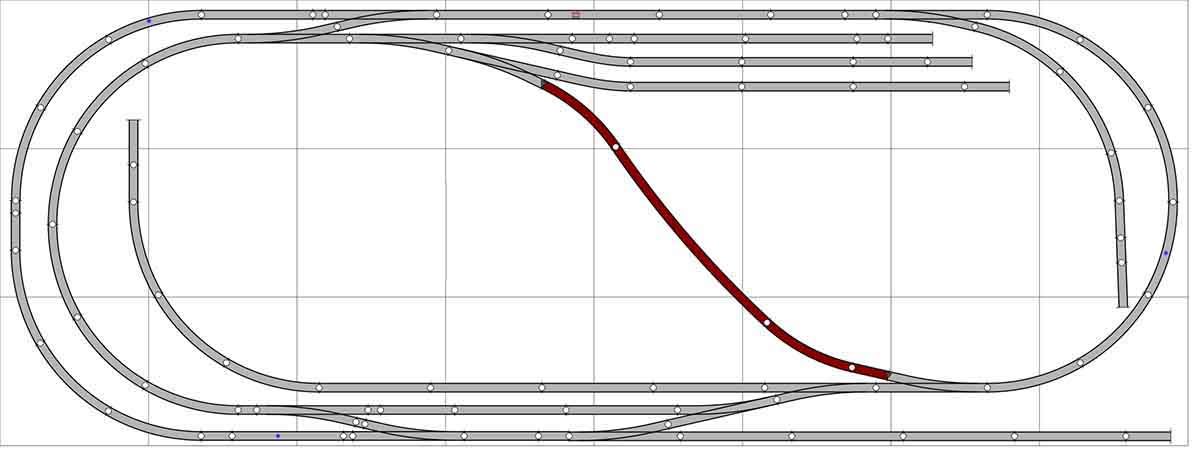
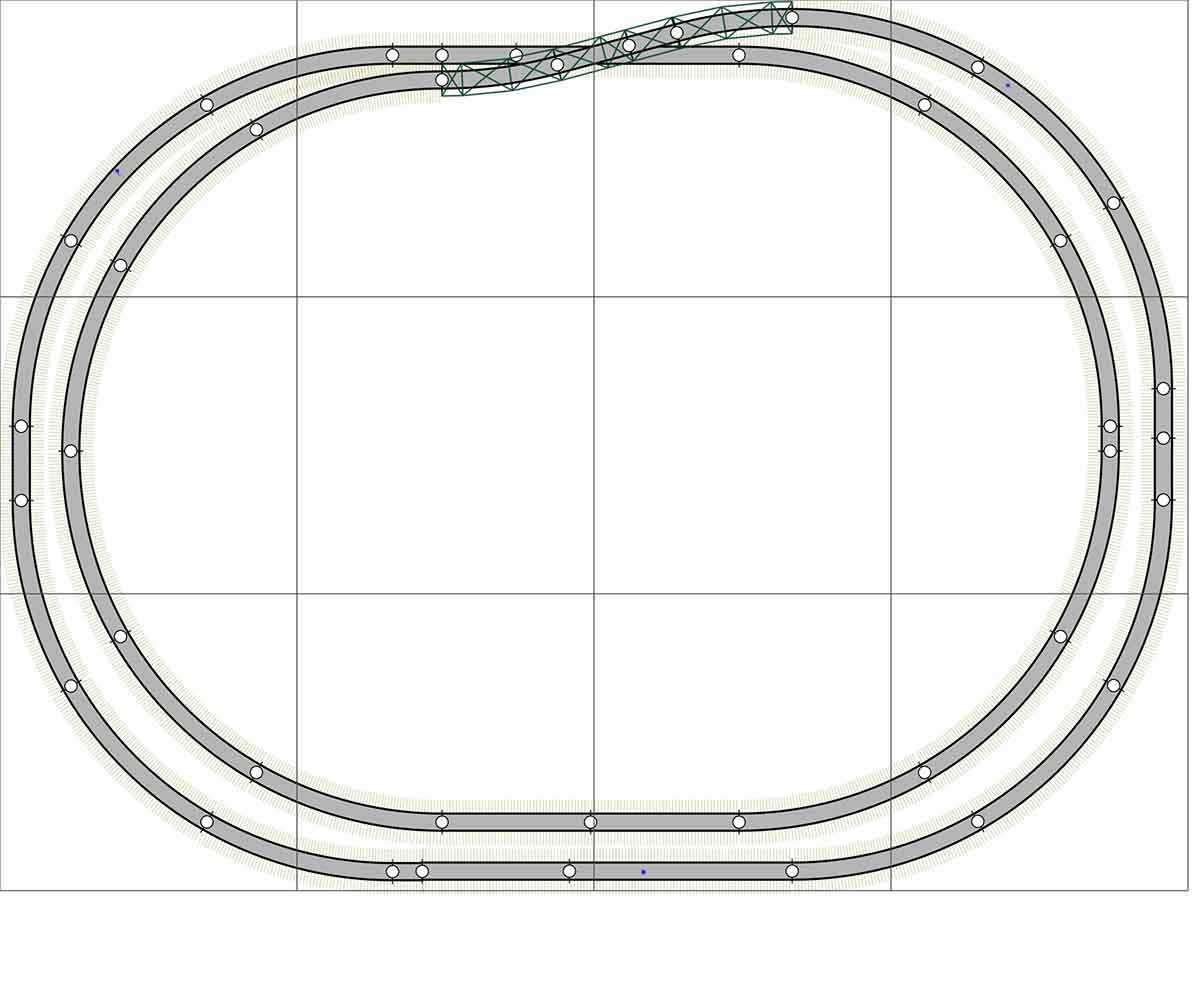
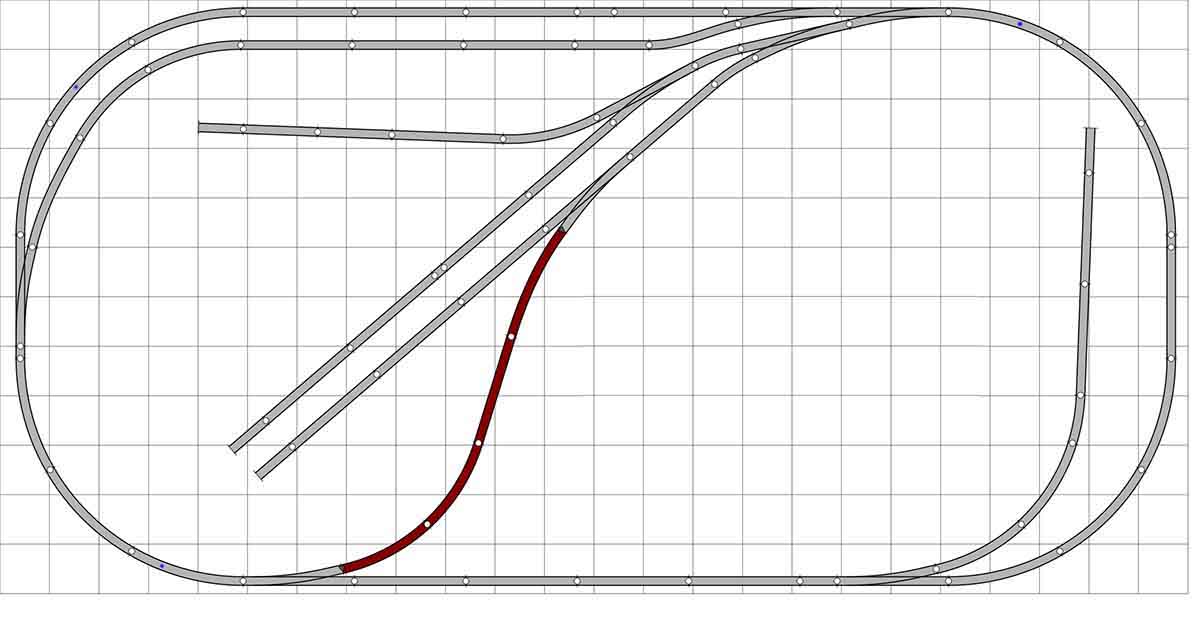
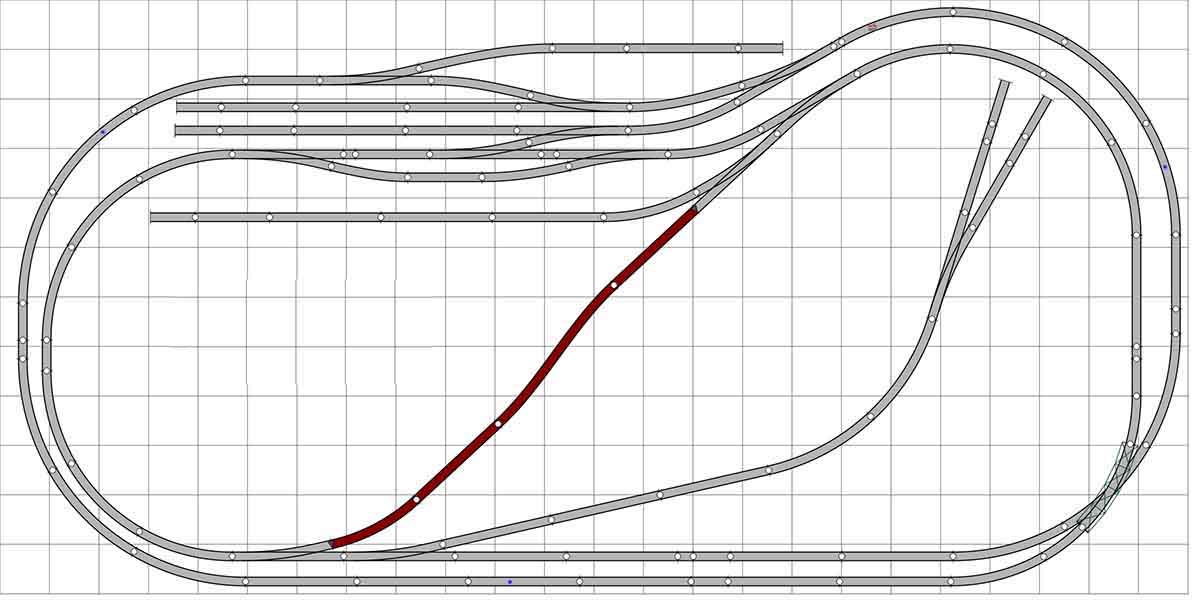
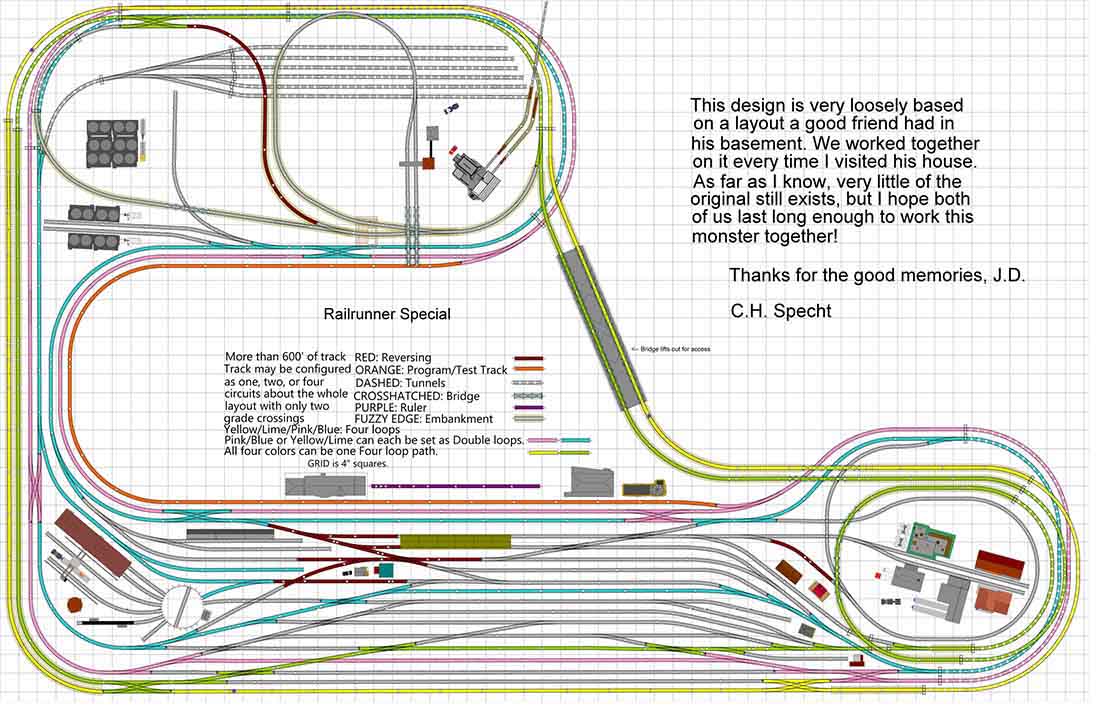
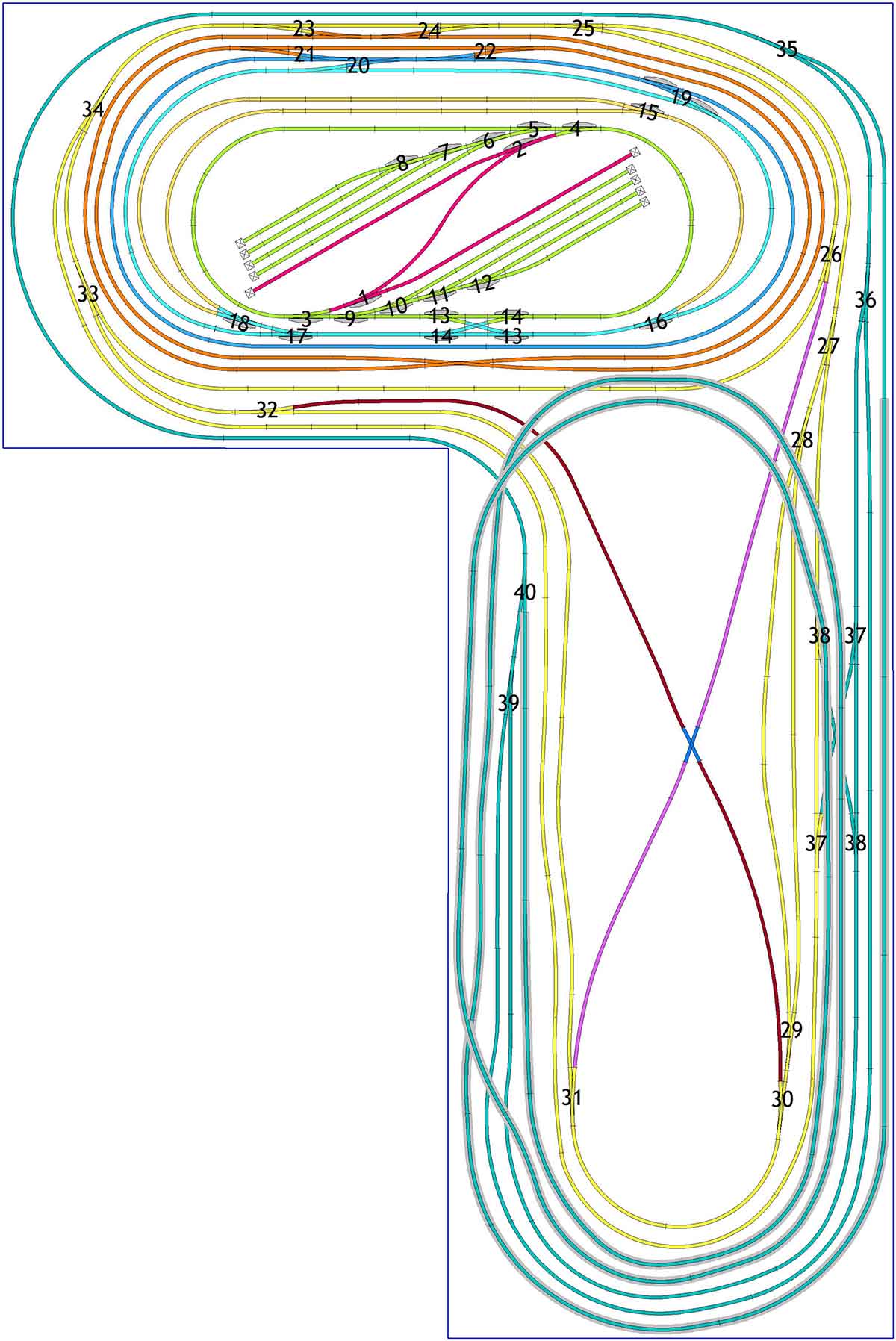

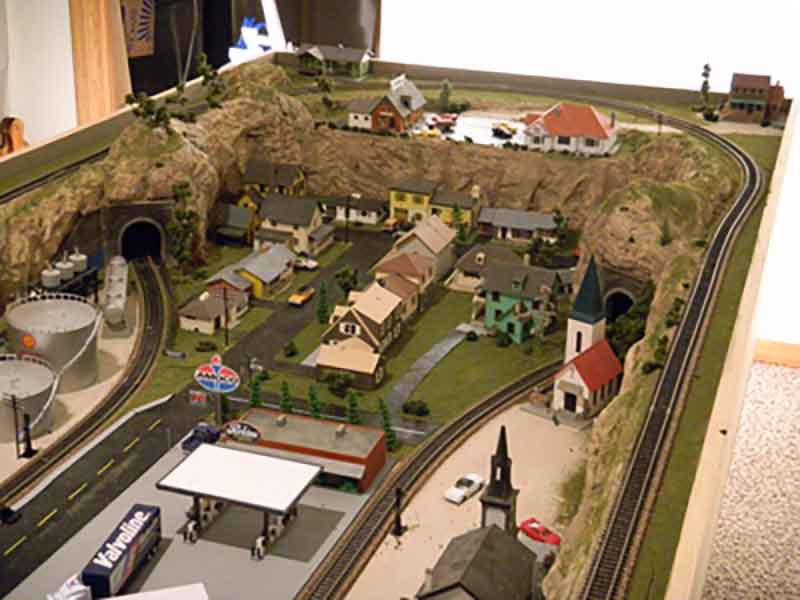
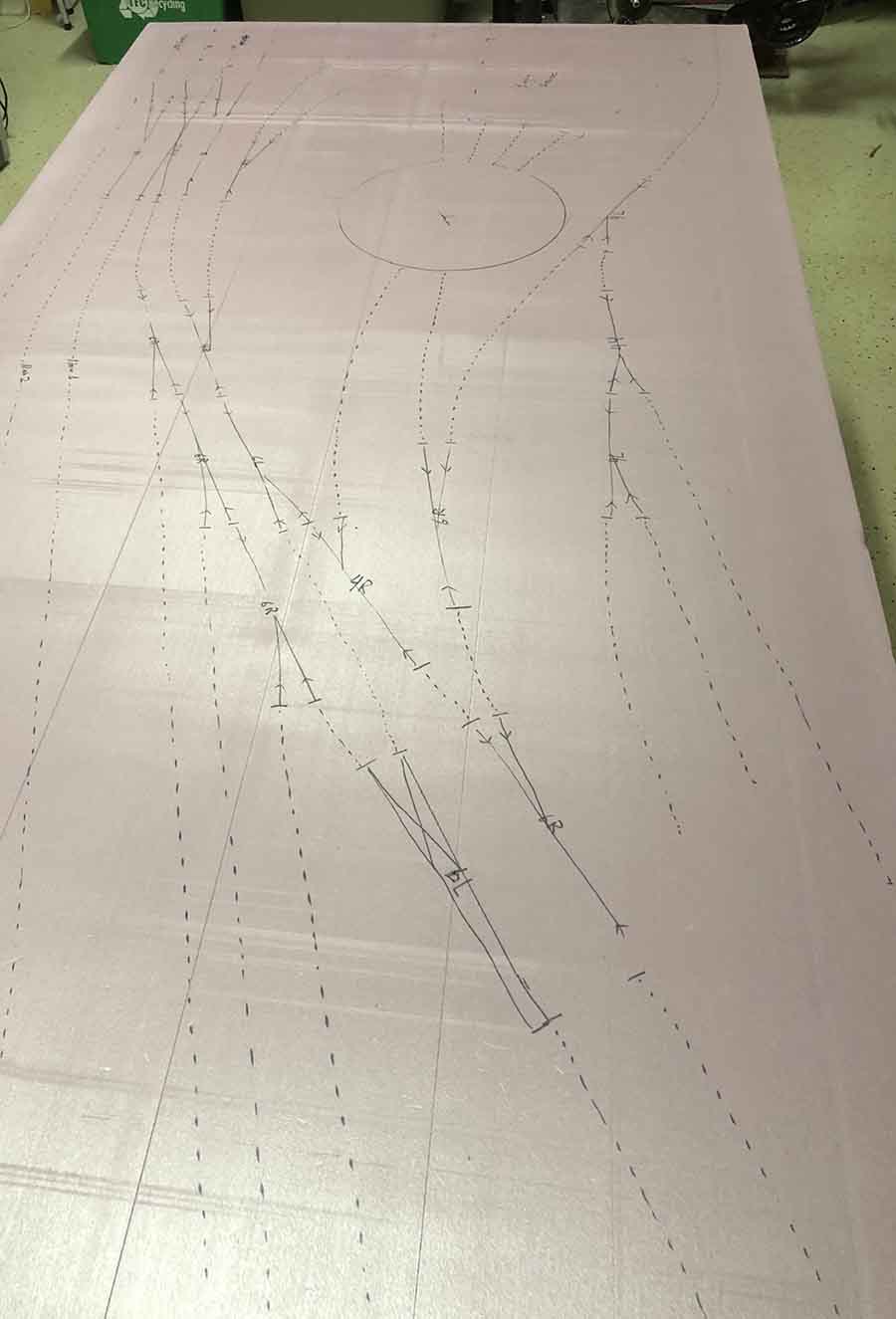

Charlie From Las Cruces… My Dad Moved There And Moved Back To Wisconsin After 9 Years, & I Rode AmTrak Southwest Chief To Albuquerque From ChiTown To Get There, & Greyhound Or Equivalent. And THEN Back In Madison Wisc. We Were Gonna Do Ho/Hon3 With Shays, But A 5 By 10 Table & Diminishing Eyesight Kinda Crimped Our Dreams… I Do Have 2 Shay Kits From, I Think Baldwin, Or Some Other Out Of Business Company If You’d Like Mineral Or Timber Locos: LOVE The First Track-Plan, & Much Thanks To Alastair Of Course.
This is a hobby that suits everyone and everyone to his own. Personally, I like to create little real-life ‘cameos’ and to give a sense of space and reality. To me, some layouts are so ‘cluttered’ with track that they lack any sense of realism. I know Dangerous Dave has a lot of space for his layout but he has created scenes from real life situations and, while he certainly does ‘…run trains’, they run through realistic scenes that I find interesting and attractive.
What i have said above is definitely not intended as a criticism but merely stating an opinion of what I like and have aimed for on my layout.
Some years ago I purchased the anyrail software package for designing track layouts. I have used it successfully for both OO gauge and T gauge layouts. It is easy to use, has all major track types included and handles flexible track well. Prints at any scale can made. You can then lay a full size printout on the track board to guide laying the track. I use a smaller print out as a mimic diagram for the control panel.
Although it looks a bit expensive at (currently£47) and you need a computer to use it . You avoid the hours spent adjusting curves to get smooth running and other frustrating layout issues. It makes playing with ideas for new layouts fun. I know this sound a bit like an advert for Anyrail, but I have no connection with it (other than owning a copy)
I have used AnyRail for the last 2N scale layouts and found it really useful with a range of track libraries.. Definitely worth the cost and you get regular updates for free.
The first plan was a simple door size layout and the current build (4 years and counting!) is an L shape 8′ x 7 x 3′
Still discovering old mistakes as well as making the occasional new one. All part of the fun!
Mornin’ everyone. All of the issues that made my past layouts difficult to either operate or wire were as a result of mistakes in my track plan. As an example, the plan looked great on paper, but the radius of several turns came out to 18″ on the outside loop, but that made the inside <18" so the trains have problems there, and the long passenger cars looked hinky because of their overhang. Second problem was wiring so the DC blocks could be separate so more than 1 engine could operate and do so in opposite directions, adding a reversing loop only doubled the problem. Bottom line is that a track plan that's accurate and to scale (always draw in the inside of a loop first so the outside is a bigger radius) and do your best to avoid reversing loops, even the electronic reversing circuit boards have problems in actual operation. Last point, "S" turns or back-to-back turns look great, but put real strains on model trains as the car trucks have to make too many adjustments in a short time, derailments are difficult to eliminate especially when running longer trains, it all has to do with being able to create a spiral, (impossible with sectional track) which is the transition from tangent to curved track. . Just a few thoughts. John from Baltimore
What I learned the hard way:
Turns and elevation change together are a recipe for grief. All train wheels are on a locked shaft so one wheel has to slip on a curve-much stress there.
No less than 1″ up in 4 feet long- You want to go up 5″- you need 20 feet.
Passenger trains need long curves.
Some straight after a turn or a switch
Because of the above, what may seem a simple layout, planning is required to minimize those problems depending on how complex you make it. Flat and long curves- no pre-planning needed.
Something like that Railrunner Special- must be pre-planned by hand, or CAD, or a program.
Pretty kool.!!!!!!!!!!!!! I hope mine come’s out that good.
Thinking about the things you want on your layout and then drawing it out whether on paper with a pencil or with a computer program is a very valuable exercise. It can show you what is possible and what is impossible in the space you have to work with. Great builders of anything always plan things before they start laying the stone. Planning a model railroad/railway is no small matter. It should take time to explore multiple options and see what can fit and what can be done. The act of planning gives you great insight into what it will be like when you actually start building the layout. I spent 3 months intermittently planning Farland 2 and it was well worth the time and energy. I was able to get all the things I wanted at the time on the layout. Now, of course, I want more and I will rebuild Farland again someday. Best of luck to all the model train people out there. Rob McCrain – Farland Howe
Hi Al …. don’t get me wrong we enjoy your site totally but the track plan post was way too much at one time. Should discuss only about one or two at one time. Also there is no way one should attempt any of the complex ones without using DDC. The first track plan shown is even complicated to know where the reverse loops separations should be located.
Please have someone answer that question. If not, the hobby turns out to be tooooo complicated. Thank you.
i am interested in charlies 3 x 8 layout at the top of this e-mail. can i get the number of track (straight and curved) used and the switches used?
Ever since my first lionel layout I’ve always jotted down what I would like to build.Always paper and pencil. Good eraser too!! I’m in the process of adding sidings to my small n scale and I’ve done alot of drawings to find the one I really like. Still drawing!!!
Would like to meet up with Charlie. I have always loved trains. Have a HO set up in my garage that can’t get it the way I want. I live in Mesilla Park, NM
Let us talk about planning. I am retired military and there is a saying of the 6 P’s. “Prior Planning Prevents Putrid Poor Performance.” At least that is what is said in polite company. The fourth P is really the “P” word for urine.
Lester, in Jawga USA
I’ve always enjoyed “doodling” track plans, ever since I was a teenager. Now I’m retired and planning a small switching layout that will fit in a 9×10.5 ft room. For the last 10 years or so, I’ve used graph paper. Depending on how detailed I want the plan to be, I assign each square on the graph paper to represent either 3” or 4”. I’ve found this method allows me to account for turnout space, spacing of tracks (especially on curves) and the footprint for structures. I also found the book: “Track Planning for Realistic Operation” by Armstrong a very good resource. The room is almost ready to begin construction.. I’ll be sure to send an email to Al, with pics, when the “start” occurs.
George and Rob said it best. Truly there are many factors in model railroading. Space is usually the best place to start. Five pounds of…..won’t fit in a one pound bag. A track plan should be realistic (or not) and not overly complicated. I’d recommend DCC for power. I prefer realistic scenery to complement the track plan and a time period of ten to twenty years for modeling engines, rolling stock, structures, buildings and other layout features. Trial and error and too many, worked for me. But it usually comes down to a personal choice of what you want to model and how much time and money you can afford. Some folks like to feature electronics, some, detailed scenery and some just want to run trains. It’s all good and it’s still the best hobby in the world.
Jim AZ
I think that it is important to work from a layout plan; but one also needs to be flexible. I’ve designed hundreds over time using AnyRail 6 software; but haven’t committed to any one…yet. I’ve sold all of my DCC locomotives to return to simple DC…primarily due to a new found interest in the railroads of Japan…especially the early 20th century locomotives. I’m nearly 70 now…live in a modest American home (880 square feet w/ a full basement), sharing it with 3 active dogs (a Border Collie, a Border Collie mix and a Dachshund mix), so my space is limited. I’m NOT a good scenery artist…and my joy is simply watching trains RUN…still a kid at heart in that manner! To that end, I designed a 48″ square layout featuring one Figure 8 surrounded by 3 loops. No sidings or yards…and just enough room for a few structures and scenery…and dimensions to fit Kato Pocket Line trains, small Japanese Electric and Diesel locomotives, “C” type Japanese steam locomotives, an American Shay, Consolidation steam, GG-1s and EF-2s…NOT all at the same time; but…you get the idea. Unsure how to send a visual of the Kato Unitrack track plan; but I’d like to!!!
When I was young and had the full run of my family’s basement, I built a couple of pretty large HO layouts without first drawing a detailed track plan. My third layout had to be more compact, so I drew it out using graph paper. Fast forward 35 years, my fourth layout, this time in N scale, needed to fit on a 36”x80” door, so I spent a few months using SCARM to create a very detailed plan that served me very well. And I used it again when I added a 36”x54” staging extension. Handy stuff!
I think there are a lot more ways to address track design then there are designers or tools. I also believe that in many instances, the desired result is not in concrete and in my case it was a good thing. I tried making a track plan, several times, also tried planning the other pieces of a model train layout, such as a farm, a small business district, small industrial area, an airport and a gold mine. I decided my era to model would be mid 40’s to mid 50’s. yeah, I know about the gold mine.
After I had my initial table built, using available space, I started laying out actual track from ideas in my head. First problem was curve radius, and decided to use 15 inch radius curves almost everywhere. I guess I was designing on the fly, as I spent at least a month trying different designs and solving self made problems. Final result was a pretty simple one way DC powered layout that is more about a town and a story or two with a railroad running through it.
Also I have made every mistake in the book and maybe some new ones, have learned just a little of what I need to know and had gobs of fun. I am very thankful for what Al has done with this site and all the very talented subscribers, who have helped me get ideas and see the right way to do so many things.
My advice for someone one new to the hobby would be this; buy some track, hook it up, even if just one locomotive and go for it. Regards to all!
Question: When constructing/designing a layout, does it matter what direction the trains run? Clockwise or counter clockwise?
Clockwise? Counterclockwise? Really makes no difference to the train, but makes a teriffic difference to your eye. Sometimes a train running one way just doesn’t look right.
Going up or down hills does make a difference, though. Steeper slopes that just can’t be avoided on some layouts always are easier on the engine if you are decending.
I, personally, don’t worry about the direction of the clock. I went digital (DCC) and run the way it looks best.
I have found the free AnyRail software helpful but now building my 4th layout it is only a guide. Something that looks OK on paper may not look OK when actually constructed on a baseboard. Too cluttered is a frequent comment made on this wonderful site and this is something that becomes more obvious when looking at the actual layout.
Andrew in Oz
Great debate guys, but I know which side I come belong on.
I must have a plan. Why? Just cos I do.
I have great respect for folks who can visualise what they want to do and just build it “out of their heads”, but I need to plan it all carefully and document my plans or I’ll forget something vital in the building. I use DC, so I’m in for some fairly complex wiring and without some records, that can get tricky
So, I use SCARM. I print out the plans, mark them up with coded connection numbers, with a “tag number” for every section and accessory they requires power and build from there, marking up as 8 complete the sections.
I also like messing around with the track plan before I build and working out the movements.
I don’t think I could have got storage loops, double track main line, terminal station, through station, loco depot, and a reverse loop to give me out and back as well as continuous running in 8ft 6” x 5ft without planning it all out very carefully without using a planner, be it SCARM, Anyrail, or any other planning programme.
But that’s just me. There’s no right and wrong, so it’s each to their own as long as it’s fun!
Is the Railrunner Special layout operable? I don’t want to start to build it to later be disappointed when it won’t work.
I thought about using Anyrail to prepare my layout but I’m not the best at using a computer. I did sketch out an initial plan on graph paper and actually had an operating setup when my granddaughter (for whom I am building my layout) suddenly decided she wanted the train to go through a mountain and up a mountain and across a bridge. I’m working in O gauge, 3 rail, which takes up a lot of room to comply with her wishes. I’m redoing the entire layout and finding that I will have much less room for scenery and buildings!
Thank you to Al for creating this site and for all of you fellow modelers for ideas and solutions to problems.
Charlie, what scale laout are you building” Why did you pick such an oddball grid as 4″ squares? Just trying to determine the overall size and a few critical dimensions were maddening with that grid, Most work with a 12″ grid, or if you want a finer division on the plan the 6″ or even 3″ grid is much more natural, and varying the grid lines into 2 or 3 different weights 12″ lines heaviest, 6″ grid lines medium weight, 3″ lightest lines. Personally I use and highly recommend the free layout program Xtrack-cad. Best and easiest to learn layout software out there. Runs on anything running IOS, Windows or Linux. Even though it is free the developers behind it are almost manic to make it the best out there, keep it updated and bug free. There are so many features that are really needed in track planning, such as easements, grades, changing radius curves clearances between flyovers, minimum radius in curves, increasing/decreasing spacing between parallel curves so longer locos and rolling stock don’t sideswipe each other or stationary track-side objects. You can run simulations of actual scale train consists with a throttle like interface to see how it runs. There are accurate parameter files for about any track, manufactured or hand laid, in scales from T to 5″ live steam! as well as parameter files for many of the popular structures. There is a large active user base, so help is just a day or less away!
The biggest criticism I can make on Charlie’s plan are the turns too tight, do the flyovers actually have clearance without excessively steep grades, and although there is a lot of track, why does it exist, where are the trains going to and/or from, and why? There is a large classisfication yard and staging yard, but what are they classifying and why? If you are going to have trains just circling in 1, 2, 3. or 4 laps around the thing, Then you are buying and laying a lot of extra track that few wheels will ever roll over, In My Humble Opinion.
This layout started with two seperate layouts on two adjacent tables.
One table had a small yard, two track mainline, a turntable, and three or four sidings. The orther table had a mountain, two levels of track, and some simple scenery.
My friend wasn’t happy with either layout and had piles of track to spare.
We started by connecting the two tables with a connection across one end and expanding the two track mainline around both tables.
Then we added the long climb from the lower track on one table to the second layer on the other.
We rearranged his yard, moving the turntable and making room for a long bridge like you see in the “Special”.
About that time we both left college and I got “volunteered” for the Air Force.
I think I worked with him maybe once or twice before marriage, moving between jobs, and life in general intervened.
What we had worked very well.
RailRunner Special covers most of what you and others have talked about, and
i have made a few changes from ideas and suggestions garnered from this site.
The only curves that are less than 18″ radius are in the yard and a very few other places. I have been very careful with spacing and have used as little flextrack in the design drawing as possible. (I expect to use a LOT of it in the real thing!)
The biggest design hassle I have found is that no one makes crossovers and slip switches with the same turn angles as the switches! Even within the same brand. It forces you to use flex to straighten out those tiny twists that just won’t
come together. It does make the train movement a bit more realistic.
Almost all slopes are less than 3° except up to the mine.
I agree that there appears to be no “story” with this layout, but that’s not my source of enjoyment in model trains. I’m more into what I can do and can I make it work the way I want to.
As an electronic technician with over 50 years of experience, the control, automation, and operation of a complex layout are my idea of fun!
My next major project (after moving 1800 miles) is designing the interface to allow a computer to follow the trains without the expensive DCC method of block monitoring.
I uinderstand the huge amount of work I have ahead of me, am looking forward to the challenge, and am accepting all comments and criticism I have received from all of you that are as crazy in the same way I am!
Charlie
Note to Al: Give my email address to David Wells
incredable track layouts. i remember a bunch of my friends that used to have setups like these. lots of work, but worth it when done.
Well I dare say I didn’t pre plan a track layout , I had I limited pre determined space to work with . Being a novice and primarily ignorant to the finer details of model railroading I simply began with laying out track that would suit my space dimension as well as allow for structures and scenery . I had some specific criteria I wanted to meet , tunnels , bridges and such so I just sussed out what would work . My layout is rather rudimentary but very fun and never boring . I have six locomotives on six separate rail systems they run simultaneously on multi levels .. lower middle and top tiers . However it seems imperative that one should indeed have a plan before getting started whether it’s an all out detailed track plan and scene plan is mostly up to the individual. Having turnouts and spurs I and reverse loops I would think would indeed require forethought and planning . That being said, sometimes it’s overwhelming trying to determine which plan suits you best . Too much input and stimulation may result in an idle start . Find one that works and have at it I say , wether it’s a computer determined idea or one from you imagination it really doesn’t matter , what matters is you like it , it works and you get started . Nicest thing about this hobby is you can always try again and do it differently.
Charlie and Dave, I’m also in Las Cruces. No layout until we can buy a place. Al : OK to give these guys my email!
How about modeling a flooded town!
Scott,
Would you be willing to send me a copy of your plan in SCARM?
Al, you can share my email with Scott.
Thanks to both of you.
Lots of great ideas here. We have some very helpful contributors with plenty of experience.
I found the considerations for a layout came down to these few things in the initial stages:
1 Space available – this will be the main determining factor since there is no such thing as unlimited space for most railway modelers.
2 Scale – For long trains and scenery a smaller scale is better; for accurate detail a larger scale is preferable, especially if you intend making a lot of the locos or rolling stock yourself.
3 Operation – Do you want continuous running, point to point, or Marshaling challenges?
Get these first decisions right and you can go to other things such as the amount of track vs scenic realism, era and type (branch-line, main line, industrial etc).
I use Anytrack software and find it useful once you have had some practice with it.
I am a music arranger/composer, so I am loaded down with apps most of them are very complex with a steep learning curve. Years ago I used 3rd planit and designed an N scale layout featured in N scale magazine September 1996. That was the last time. When it comes to my latest pike I tapped into my sketching skills and went from there.
My HO pike is a double folded dog bone in an 18’x 14′ space. The majority of my track is flex track which allows much more flexibility (pun intended) in the right-of-way. For what it is worth in my thought reverie will long distance bicycling I would plan, complete, and ride on my layout. But the bottom line is that this worked for me.
I tried scenery too, and I’d rather run trains! What PC program are you using?
I’m very glad I planned out Diano Marinaon paper first
The sea moved from outside to inside the tracks, a hotel moved a block, train lengths were established and I realised the fiddleyard had to be wider than expected.
As an aside, could I put a word in for modelling a real place? It’s still creative in seeing how you could fit your favourite features of the place into a working scene, and it makes you model things you’d probably not imagine (Diano has a station toilet block with a palm tree growing out of one corner, for instance) and at the end of the day, even if it’s not modelling brilliance, it’s still a bit of history preserved for posterity.
Hello,
First, Thanks for the great website.
Second the layout designs shown are referred to as
spaghetti layouts.
They do not relate to real world track design.
I’m not dissing anyone who wants this, we can choose what we want in
a track plan.
However single line design using sidings and small yards in a round the
wall design will be easier to build and maintain.
These type of designs also need less loco’s and rolling stock.
I wish you all well and good luck in your modeling.